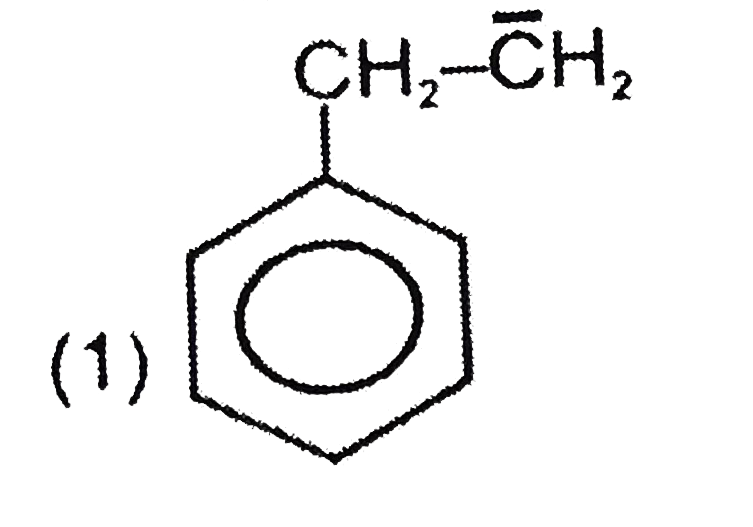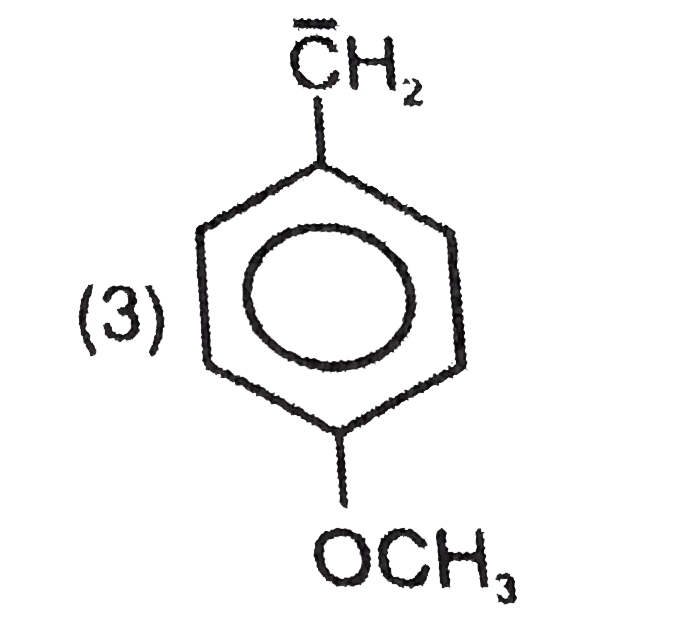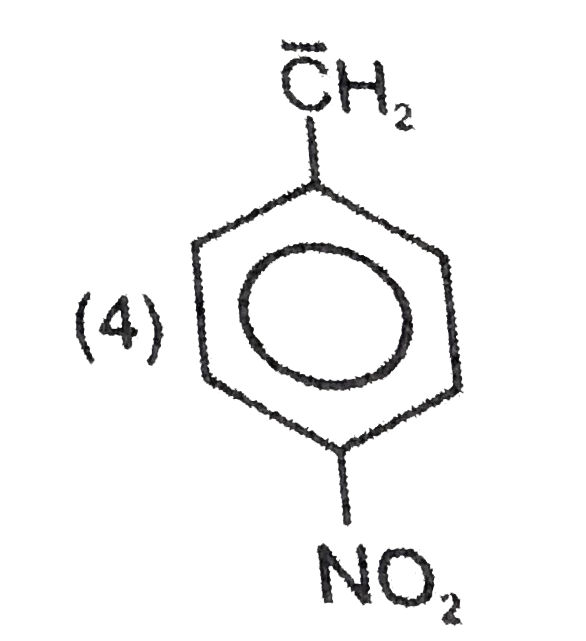The most stable carbonium ion among the following is
C6H5+CHC6H5
C6H5+CH2
CH3+CH2
C6H5CH2+CH2
The correct Answer is:A
To determine the most stable carbonium ion (carbocation) from the given options, we will analyze the stability of each structure based on resonance and inductive effects.
1. Identify the Structures:
- The first structure has two phenyl groups attached to a carbon atom with a positive charge (C6H5-CH^+-C6H5).
- The second structure has one phenyl group and a positive charge on a carbon atom adjacent to a CH2 group (C6H5-CH^+-CH2).
- The third structure has a positive charge on a carbon atom adjacent to two hydrogen atoms (CH3-CH^+-CH2).
- The fourth structure has a positive charge on a carbon atom adjacent to two CH2 groups (C6H5-CH2-CH^+-CH2).
2. Analyze Resonance Effects:
- In the first structure, the positive charge can be delocalized over the two phenyl groups through resonance. This delocalization stabilizes the positive charge significantly.
- In the second structure, the positive charge is only partially stabilized by the single phenyl group. There is some resonance, but it is less effective than in the first structure.
- The third structure has no resonance stabilization as the positive charge is not adjacent to any electron-donating groups. It is only stabilized by the inductive effect from the CH3 group.
- The fourth structure has no resonance stabilization either, as the positive charge is not in direct conjugation with any phenyl group.
3. Evaluate Inductive Effects:
- The third structure (CH3-CH^+-CH2) has a +I effect from the CH3 group, which provides some stabilization.
- The fourth structure (C6H5-CH2-CH^+-CH2) has no significant stabilization due to the lack of resonance.
4. Rank the Stability:
- The first structure is the most stable due to extensive resonance stabilization.
- The second structure is less stable than the first but more stable than the third and fourth due to some resonance.
- The third structure is more stable than the fourth due to the +I effect from the CH3 group.
- The fourth structure is the least stable due to the absence of resonance and inductive effects.
5. Conclusion:
- The most stable carbonium ion among the given options is the first structure (C6H5-CH^+-C6H5) due to the resonance stabilization provided by the two phenyl groups.
Final Answer:
The most stable carbonium ion among the following is the first structure (C6H5-CH^+-C6H5).
---
- The first structure has two phenyl groups attached to a carbon atom with a positive charge (C6H5-CH^+-C6H5).
- The second structure has one phenyl group and a positive charge on a carbon atom adjacent to a CH2 group (C6H5-CH^+-CH2).
- The third structure has a positive charge on a carbon atom adjacent to two hydrogen atoms (CH3-CH^+-CH2).
- The fourth structure has a positive charge on a carbon atom adjacent to two CH2 groups (C6H5-CH2-CH^+-CH2).
- In the first structure, the positive charge can be delocalized over the two phenyl groups through resonance. This delocalization stabilizes the positive charge significantly.
- In the second structure, the positive charge is only partially stabilized by the single phenyl group. There is some resonance, but it is less effective than in the first structure.
- The third structure has no resonance stabilization as the positive charge is not adjacent to any electron-donating groups. It is only stabilized by the inductive effect from the CH3 group.
- The fourth structure has no resonance stabilization either, as the positive charge is not in direct conjugation with any phenyl group.
- The third structure (CH3-CH^+-CH2) has a +I effect from the CH3 group, which provides some stabilization.
- The fourth structure (C6H5-CH2-CH^+-CH2) has no significant stabilization due to the lack of resonance.
- The first structure is the most stable due to extensive resonance stabilization.
- The second structure is less stable than the first but more stable than the third and fourth due to some resonance.
- The third structure is more stable than the fourth due to the +I effect from the CH3 group.
- The fourth structure is the least stable due to the absence of resonance and inductive effects.
- The most stable carbonium ion among the given options is the first structure (C6H5-CH^+-C6H5) due to the resonance stabilization provided by the two phenyl groups.
The most stable carbonium ion among the following is the first structure (C6H5-CH^+-C6H5).
Topper's Solved these Questions
- BASIC PRINCIPLES OF ORGANIC CHEMISTRYBOOK - DINESH PUBLICATIONCHAPTER - BASIC PRINCIPLES OF ORGANIC CHEMISTRYEXERCISE - SELECTED STRAIGHT OBJECTIVE TYPE MCQS
64 Videos
- BASIC PRINCIPLES OF ORGANIC CHEMISTRYBOOK - DINESH PUBLICATIONCHAPTER - BASIC PRINCIPLES OF ORGANIC CHEMISTRYEXERCISE - LINKED COMPREHENSION TYPE MCQS
10 Videos
- BASIC PRINCIPLES OF ORGANIC CHEMISTRYBOOK - DINESH PUBLICATIONCHAPTER - BASIC PRINCIPLES OF ORGANIC CHEMISTRYEXERCISE - Matrix Type Questions
2 Videos
- ALKALI EARTH METALSBOOK - DINESH PUBLICATIONCHAPTER - ALKALI EARTH METALSEXERCISE - Unit test-12
5 Videos
- BIOMOLECULESBOOK - DINESH PUBLICATIONCHAPTER - BIOMOLECULESEXERCISE - MATRIX - MATCH TYPE
8 Videos
Similar Questions
Knowledge Check
The most stable carbonium ion is,
AMethyl carbonium ionBPrimary carbonium ionCSecondary carbonium ionDTertiary carbonium ion.The most stable carbocation among the following is
A B
B C
C D
D
The most stable carbanion among the following is
A B
B C
C D
D
Most stable carbanion among the following is
View SolutionMost stable carbanion among the following is
View SolutionMost stable carbocation among the following is :
View SolutionSelect the most stable carboncation among the following -
View SolutionSelect the most stable carbonium ion from amongst the following
View Solution
